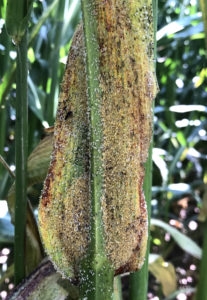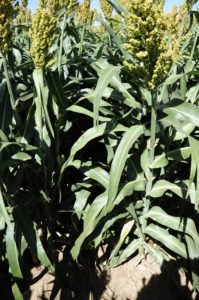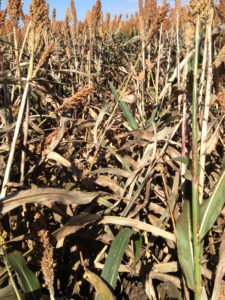Study: Forage Sorghum Silage an Option with Sugarcane Aphid Control

Forage sorghum silage in the Texas High Plains is a viable option with sugarcane aphid control, according to a Texas A&M AgriLife Extension Service study.
Texas High Plains feedlots and dairies demand large quantities of quality silages. While corn is the predominant silage crop, declining well capacities and pumping restrictions are prompting interest in forage sorghum silage.
Severe sugarcane aphid damage. (Texas A&M AgriLife photo by Dr. Jourdan Bell)
The concern, however, is with sugarcane aphids, or SCAs, and whether heavy infestations will allow proper ensiling, said Dr. Jourdan Bell, AgriLife Extension agronomist in Amarillo. Also, producers question if damage to the forage will degrade further during the fermentation process.
SCA infestations in forage sorghum silages the past three years have been extremely heavy, causing harvest issues, Bell said. But prior data on the actual amount of damage to silage yield and quality from these infestations is nonexistent.
“While we previously documented a direct correlation between increased SCA damage and decreased forage quality at harvest, we’ve never evaluated the effects of SCA damage to silage quality over time,” she said.
The Bottom Line
In 2017, Dr. Ed Bynum, AgriLife Extension entomologist in Amarillo, and Bell conducted a field trial to evaluate damage potential of SCAs to forage sorghum yield and silage quality. The research funding came from the Texas Grain Sorghum Board. Find the full study outline at https://tinyurl.com/sorghforageSCAdamages.
Bynum said while it is known SCA damage adversely impacts forage tonnage, the study helps determine the effects on ensilage quality.
“For example, a study on spider mite damage to corn showed that as spider mite infestations increased, plant damage increased, resulting in declining silage yields,” he said. “But the spider mite infestation levels did not affect the nutritional quality of the corn silage.”
Study data indicate the damage SCAs cause to yields from the milk stages to harvest will impact the yield and quality of the forage, Bynum said.
The plot from the study treated with Sivanto Prime at 10 fl oz/ac. (Texas A&M AgriLife photo by Dr. Ed Bynum)
“Since populations can develop rapidly, producers should control SCAs to prevent damage during the flowering and early grain development growth stages,” he said.
Ultimately, Bell said, the quality of the silage is only as good as the quality of the harvested forage. So, when managing forage sorghums, timely SCA management is necessary to maintain fresh and ensiled quality.
Managing the Infestation
Using a commercial forage sorghum hybrid commonly grown for silage in his study, Bynum said he expects this data to apply equally to other hybrids.
Insecticides with different efficacy levels and a check with no treatment allow different infestations and damage levels in the plots. Treatments include Sivanto Prime, at rates of 5, 7 and 10 fluid ounces per acre; Intruder, 1 fluid ounce per acre; Warrior II, 1.92 fluid ounces per acre; Lorsban Advanced, 16 fluid ounces per acre; and an untreated check.
Applying Sivanto Prime at three different rates allows monitoring of different levels of control and damage, Bynum said. Warrior II is a pyrethroid that does not kill sugarcane aphids but will kill beneficial insects, resulting in a rapid flare of SCA populations. Lorsban Advanced and Intruder are two insecticides that only suppress sugarcane aphid populations for a few days.
The plot treated with Warrior II at 1.92 fl oz/ac caused sugarcane aphid pressure to flare resulting in lodging and yield-limiting damage. (Texas A&M AgriLife photo by Dr. Ed Bynum)
Sivanto provides excellent control at the higher rate and with the 5- and 7-fluid ounces per acre application rates at flowering before heavy aphid infestations, he said.
Both Lorsban Advanced and Intruder delay populations from building for a week, Bynum said. This delay prevents substantial yield losses when sorghum harvest is at the soft dough stage. However, if harvest is at a later growth stage, the yield losses may be substantial.
SCA density levels start causing significant increases in damages by Sept. 1 when sorghum is in the beginning milk stage in the untreated and Warrior plots, he said. Damage levels in these two treatments continue to increase and remain significantly higher than the other treatments from Sept. 8-20.
Monitoring Forage Damage
Bell said forage from the trials was ensiled for 60 days. The quality of the ensilage was then compared to the quality of the forage at harvest.
Crude protein, lignin, starch, acid detergent fiber and in-vitro dry matter digestibility were all negatively affected by the damage in the untreated and Warrior treatments, she said. There is no statistical difference between other insecticide treatments for the fresh forage.
Total digestible nutrients, milk per ton and relative quality are industry standard values for forage comparison, Bell said. At damage levels greater than 4.5, all of these values decrease for harvested forage. This reflects a significant reduction in the fresh, harvested forage quality with increasing SCA damage.
Depending on the end-user needs, crude protein and starch are also important parameters, she said. These levels decrease with increased SCA damage, due to a lack of grain development.
“When evaluating forage quality after ensiling versus at harvest, we found ensiling did not stabilize quality parameters,” Bell said. “Following 60 days of ensiling, there is a significant reduction in lignin, in-vitro dry matter digestibility and starch levels. This indicates quality for heavily damaged forage is not stable during the ensiling process.”










